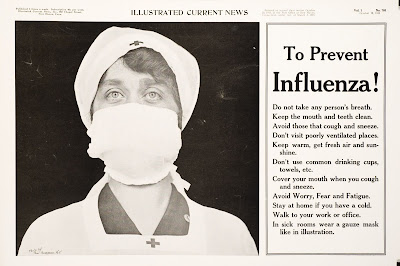Influenza outbreak reaches Cuba City
Image from the Illustrated Current News (New Haven, Conn.), October 18, 1918. Courtesy of the National Library of Medicine #101580385.
In 1918, an influenza pandemic spread across the globe, killing at least 50 million people.
By October of that year, the outbreak had reached Cuba City. Residents had just celebrated the lifting of the quarantine for infantile paralysis (polio) a few weeks earlier when they faced this new health scare.
The following notice was published in the Cuba City News Herald on October 11, 1918:
IMPORTANTTo whom it may concern: All public gatherings, dances, moving pictures, churches and schools are closed and persons are not to gather in the Post office lobby until further notice.Spitting on the side walk is prohibited and if you do not want to be fined act accordingly.The Board of Health advises the use of the face mask by all persons who are caring for the sick. An efficient mask is made by tying over the nose and mouth a double fold of cheese cloth, or clean linen. The germs of the disease find entrance into the body by the respiratory passages. A gargle used frequently of salt and water is a good preventative measure. The living rooms should be frequently flushed with fresh air. All discharges by coughing or sneezing should be deposited in cloths which should be immediately burned. Avoid chilling the body, overeating or drinking of alcoholic liquors.All cases to be reported to the Board of Health within 24 hours.Cuba City, Wis., Oct. 10, 1918.
By October 18, the saloons in town were closed. On November 1, a reminder of the continued quarantine was published in the Cuba City News Herald:
ORDER OF STATE BOARD OF HEALTH
“In view of the fact that the epidemic of influenza (la grippe) throughout the state is still very serious, the state board of health officially directs that the local health authorities continue to exercise direct control over their respective localities and until further notice keep closed all schools, churches, Sunday Schools, theaters, moving picture houses or any other places of amusement, and continue to prohibit all public meetings. C. A. Harper, State Health Officer, Madison, Wis., Oct. 25, 1918”Published by order of the Board of Health of the Village of Cuba City.Dr. MacDonald
Doctors were kept busy during the epidemic. Cuba City's centennial history describes how local physician Dr. D. L. Brady "labored heroically to care for his patients in farm and city homes in that still horse and buggy day. While his livery driver drove, Dr. Brady got what sleep he could in the buggy."
I don't have figures on the number of Cuba City residents affected, but by October 4, two influenza deaths had been reported in Benton, and the Cuba City News Herald reported on October 11 that "it would be impossible to give a complete roll call of the sick this week as so many are down with the influenza."
The quarantine was finally lifted on the morning of Friday, November 8. Schools, churches, and other institutions that had been closed for nearly a month were allowed to reopen.



Comments
Post a Comment